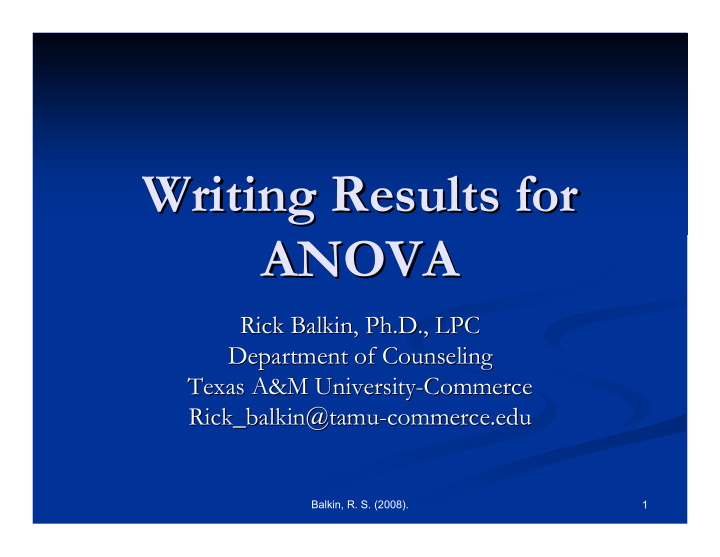



Writing Results for Writing Results for ANOVA ANOVA Rick Balkin Balkin, Ph.D., LPC , Ph.D., LPC Rick Department of Counseling Department of Counseling Texas A&M University-Commerce Texas A&M University-Commerce Rick_balkin@tamu-commerce.edu Rick_balkin@tamu-commerce.edu Balkin, R. S. (2008). 1
Reporting Results in ANOVA Reporting Results in ANOVA Statistical analyses may lend credibility and Statistical analyses may lend credibility and evidence to a particular process or procedure. evidence to a particular process or procedure. However, a strong experimental design that is However, a strong experimental design that is not investigated completely or communicated not investigated completely or communicated effectively loses credibility. effectively loses credibility. Balkin, R. S. (2008). 2
Foundations of Quantitative Foundations of Quantitative Research Research Instead of merely focusing on the statistical test, the end result Instead of merely focusing on the statistical test, the end result so to speak, a quantitative study is based on a strong foundation so to speak, a quantitative study is based on a strong foundation of a generalizable sample, reliable and valid instrumentation, and of a generalizable sample, reliable and valid instrumentation, and appropriate research design appropriate research design Statistical Test Experimental Design Instrumentation Participant Selection and Assignment Balkin, R. S. (2008). 3
Reporting Results in ANOVA Reporting Results in ANOVA The various procedures discussed in this lecture should The various procedures discussed in this lecture should be mentioned in a results section; however, rarely are all be mentioned in a results section; however, rarely are all of these components addressed. of these components addressed. Consumers of research may be tempted to skip the Consumers of research may be tempted to skip the results section when investigating effective procedures results section when investigating effective procedures and programs. This is ill-advised, as the results section and programs. This is ill-advised, as the results section should provide adequate information related to should provide adequate information related to statistical and practical significance. statistical and practical significance. Balkin, R. S. (2008). 4
Reporting Results in ANOVA Reporting Results in ANOVA A well-written results section should include the A well-written results section should include the following: following: (a) the type of analysis conducted and the level of significance (a) the type of analysis conducted and the level of significance (b) a statement related to meeting model assumptions (b) a statement related to meeting model assumptions (c) a report on the statistical test (c) a report on the statistical test (d) follow-up procedures, if appropriate (d) follow-up procedures, if appropriate (e) a statement related to practical significance (e) a statement related to practical significance (f) a statement related to power (f) a statement related to power Balkin, R. S. (2008). 5
Reporting Results in ANOVA Reporting Results in ANOVA When reporting the results of a statistical test, the When reporting the results of a statistical test, the reader will encounter a general format: statistical test statistical test (e.g. (e.g. reader will encounter a general format: t, F ) (degrees of freedom) = observed value, ) (degrees of freedom) = observed value, probability probability t, F of type I error ( ( p p ) = ) = probability value probability value . For example, . For example, F F (3, 16) (3, 16) of type I error = 11.49, 11.49, p < p < .001, signifies that an ANOVA with four .001, signifies that an ANOVA with four = groups (4-1 degrees of freedom) and a sample size of groups (4-1 degrees of freedom) and a sample size of 20 (20 – – 4 degrees of freedom) has an observed value 4 degrees of freedom) has an observed value 20 (20 of 11.49, and there is less than one-hundredth of 1% of 11.49, and there is less than one-hundredth of 1% probability making a type I error. probability making a type I error. In other words, it is highly unlikely that this result In other words, it is highly unlikely that this result occurred simply based on chance. occurred simply based on chance. Balkin, R. S. (2008). 6
Reporting Results in ANOVA Reporting Results in ANOVA An example of a results section appears in on pp. 38-39 An example of a results section appears in on pp. 38-39 in the note pack. in the note pack. A common practice when providing results is to refer A common practice when providing results is to refer readers to a table that reports means and standard readers to a table that reports means and standard deviations of each group. Often, ANOVA results may deviations of each group. Often, ANOVA results may be reported in a table format as well. be reported in a table format as well. While the reporting of model assumptions, as While the reporting of model assumptions, as demonstrated in the top portion of the results section, demonstrated in the top portion of the results section, is not necessarily common practice, it is a good idea to is not necessarily common practice, it is a good idea to report model assumptions to identify that the statistical report model assumptions to identify that the statistical test was appropriate to the data. test was appropriate to the data. Balkin, R. S. (2008). 7
Recommend
More recommend